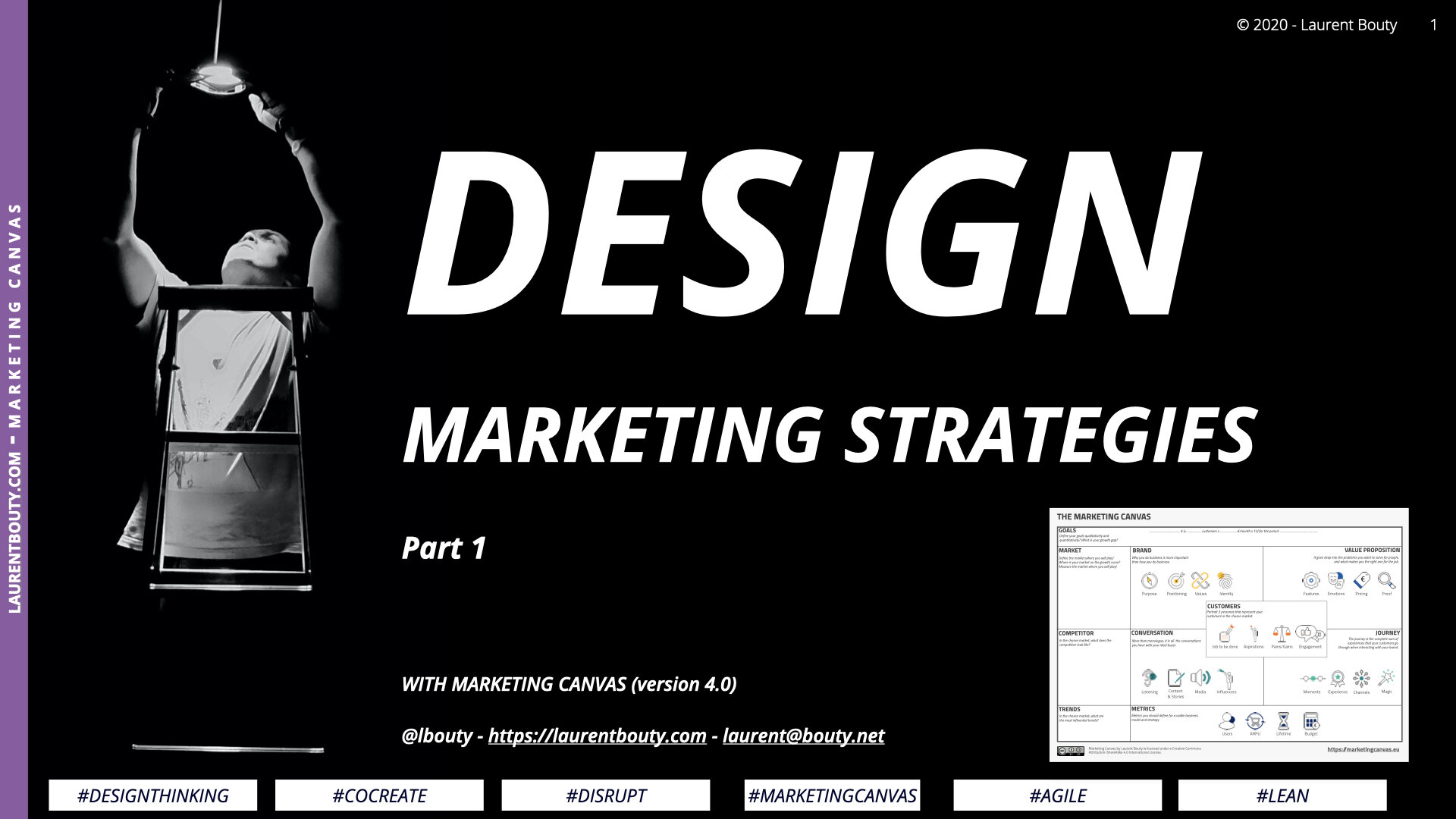INTRODUCTION
In the dynamic world of business, having a clear and effective marketing strategy is crucial. The Marketing Canvas Method, developed by Laurent Bouty, provides a structured approach to crafting a robust marketing strategy. This method is a co-creation tool designed to discover, assess, and reinforce your marketing strategy. It operates at the intersection of your environment (where you play), your goals (what you aim to achieve), and your actions (what you will do). The method includes cards, a canvas to capture key discussions, templates, and online resources.
CARDS
The tool includes 60 cards which act as your building blocks. This set is composed by recto-verso cards (format A6) specifically treated for intense usage. Each card pertains to a specific marketing dimensions (Market, Competition, Trends), Goal (your ambition), the 24 marketing sub-dimensions and assessment cards for each dimension (brake or accelerator). They are designed for heavy use and to promote engaging discussions.
PROCESS
The process is composed of 5 steps that are described below.
STEP 1 - UNDERSTAND THE CONTEXT
In this initial stage, you will explore the market conditions your brand operates in. You will consider your industry or category, identify your main competitors, and discuss the ongoing trends that could influence your marketing strategy.
Examples:
If you're running a sustainable clothing brand, your industry/category would be fashion/apparel. Your main competitors might be other sustainable fashion brands, as well as fast fashion brands. An ongoing trend could be the growing consumer demand for eco-friendly and ethically-made products.
Your mobile app development company operates in the technology industry, specifically in the software development category. Main competitors could be other app development companies or freelance app developers. An ongoing trend could be the rising demand for health and wellness apps due to increased focus on personal well-being.
Guidelines & Tips:
Come prepared with some basic understanding of your market and main competitors.
Conduct a preliminary SWOT analysis (Strengths, Weaknesses, Opportunities, Threats) ahead of the workshop.
Be aware of industry trends and consumer behaviors related to your product/service.
STEP 2 - Set your goals
In this stage, You will work on defining clear, specific, and measurable goals for your marketing strategy. These goals should align with your overall business objectives.
Examples:
A goal for your sustainable clothing brand could be "Increase online sales by 20% over the next six months.”
A goal for your app development company could be "Acquire 5 new corporate clients and increase app development projects by 15% over the next year."
Guidelines & Tips:
Reflect on your business objectives and how your marketing strategy can support them.
Frame your goals using the S.M.A.R.T (Specific, Measurable, Achievable, Relevant, Time-Bound) framework.
Goals should be ambitious but realistic, considering the resources at your disposal.
STEP 3 - Assess your goals readiness.
Here, You ll assess whether the 24 marketing dimensions represented by the cards are currently working in favor of your goals (accelerators) or against them (brakes).
Examples:
An accelerator for your sustainable clothing brand could be a strong social media presence with high audience engagement. A brake could be high production costs leading to higher retail prices compared to fast fashion brands.
An accelerator could be a highly skilled development team that's proficient in multiple programming languages. A brake could be limited marketing activities leading to low brand visibility in the market.
Guidelines & Tips:
Be honest and thorough in your assessment. This step is crucial to identify areas of improvement.
Don't shy away from acknowledging the brakes. They represent opportunities for growth and improvement.
STEP 4 - Ideate
In this phase, You ll brainstorm ways to leverage your accelerators and overcome your brakes. The goal is to generate a wide array of possible actions and initiatives.
Examples:
To overcome the brake of high production costs, you could explore partnerships with sustainable suppliers for better rates. To leverage the accelerator of a strong social media presence, you could launch campaigns to further drive engagement and conversions.
To overcome the brake of limited marketing activities, you could launch an SEO and content marketing campaign to improve online visibility. To leverage your skilled development team, you could showcase your portfolio and case studies to attract more corporate clients.
Guidelines & Tips:
Embrace creativity and encourage out-of-the-box thinking.
Consider how each idea aligns with your brand values and business objectives.
Make sure all participants feel comfortable contributing their ideas.
STEP 5 - Prioritise
Finally, You will prioritize the actions identified during the ideation phase based on their potential impact and the effort required to implement them.
Examples:
Partnering with sustainable suppliers (high impact, medium effort) might be prioritized over redesigning the website (low impact, high effort).
Implementing a content marketing campaign (high impact, medium effort) might be prioritized over hosting a tech event (medium impact, high effort).
Guidelines & Tips:
Prioritize actions that align closely with your goals and have a high impact.
Be realistic about the resources (time, budget, personnel) you have available.
Consider both the short-term and long-term effects of each action.
VISUALISE
Record your discussions and decisions. This creates a physical representation of your marketing strategy, like a roadmap of your journey.
MARKETING CANVAS - ASSESSMENT
REGULAR REVIEW AND ADAPTATION
Finally, it's essential to understand that the Marketing Canvas Method isn't a static process. Markets evolve, trends change, and new competitors emerge. Regularly revisit your marketing canvas to ensure that your strategy remains relevant and effective.
Examples:
Set a reminder to review and update your marketing canvas every quarter. This could be aligned with your business performance review schedule to ensure your marketing strategy continues to support your business goals.
Schedule a bi-annual or quarterly review of your marketing canvas. As the technology industry is fast-paced, staying updated with changes in market trends, client demands, and competition is essential.
Guidelines & Tips:
Stay alert to changes in your market context and be ready to adapt your strategy accordingly.
Regularly measure the success of your marketing initiatives against the S.M.A.R.T goals you've set.
Foster a culture of continuous learning and adaptation within your marketing team.
Congratulations
Congratulations! You've now journeyed through the Marketing Canvas Method. This tool will have helped you understand your marketing landscape, evaluate your readiness for your goals, and identify actions to achieve these goals.
Remember, marketing isn't a fixed structure, but a dynamic and evolving process. As your business grows, your marketing strategy will need to adapt. Regularly using this tool will ensure your marketing efforts stay aligned with your business goals.
We value your feedback and experiences using this method, so don't hesitate to share! This will help enhance the method, making it an even more effective tool for building successful marketing strategies.
Hopefully, this simplified and more tangible version of the Marketing Canvas Method makes it easier for non-marketers, entrepreneurs, and budding marketers to understand and apply it. Marketing can seem complex, but with the right tools, it can become a manageable and even enjoyable part of running a business.
















